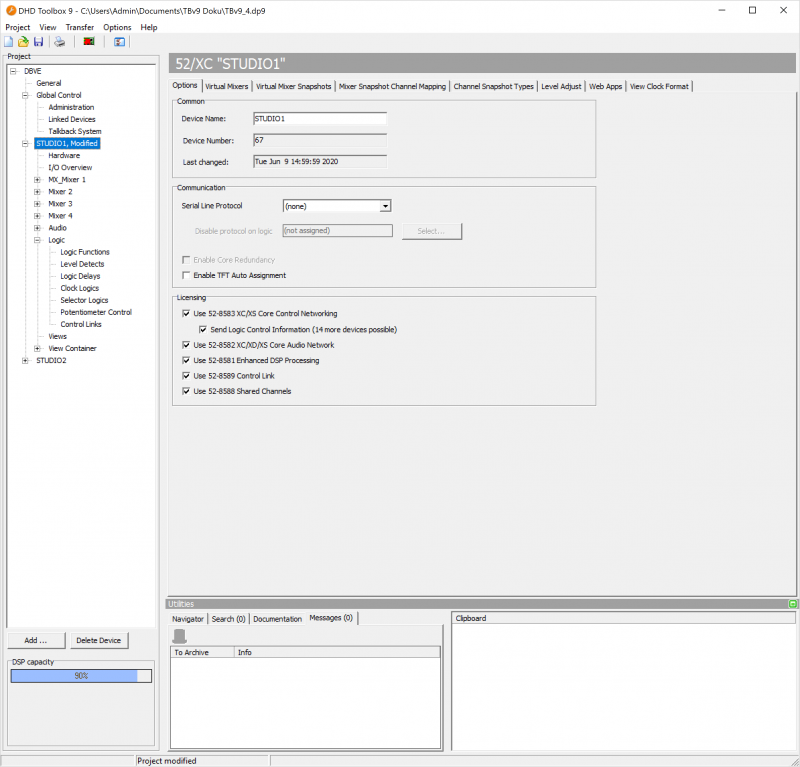<Device> Options
The Options tab on the <Device> node contains general information and settings of the device.
You can set up the following options:
| area | option | description |
|---|---|---|
| Common | Device Name | This is the name of the device which can be changed if necessary. If a project contains more than one device, you should use different names for them. This makes configuration easier because the device names are used in different lists. The device name can also be shown in the display of the different modules. |
| Device Number | This number is unique within one project. It identifies the device in the project and it can not be changed. | |
| Last changed | Here are the date and time of the last change of the device configuration shown. If no timestamp is shown here, the Config has not yet been transferred to a device. (See also Transfer Menu) | |
| Communication | Serial Line Protocol | In this list, you can select an external control protocol (Probel SWP-02, ESAM II), to control the DHD system with an external device via the serial interface. Note The license 52-8571 Pro-Bel Protocol SW-P-02 or 52-8572 ESAM-II control protocol is needed to be able to use the desired control protocol. |
| Disable protocol on Logic | Assumed the ESAM II protocol is selected, a logic can be defined that deactivates the support of the ESAM II protocol. | |
| Enable Core Redundancy | 52/XD and 52/XD2 Cores only Enables the redundancy feature for the 52/XD/XD2 core. The redundant pair of XD/XD2 cores need an external wiring that defines the Master and Slave settings. (See 52/XD Core Redundancy) Important With core redundancy enabled, APC Ports on the 52/XD2 and 52/XD cores can not be used. Use concentrators instead. |
|
| Enable TFT Auto Assignment | This options allows TFTs to get their ID automatically when checked, depending on the APC port they are connected. TFTs do not have to be assigned any more. Note The APC ports of 52-744xA 52/XD Cores do not support the TFT Auto Assignment - so a physical Assignment of TFTs with such a connection is still required. |
|
| Licensing | Use 52-8583 XC/XS Core Control Networking | To enable the features of the XC/XS Core Control Networking license select this check box. This license is shipped by default with every 52/XD Core. Important The configuration can only be loaded into the device, if the corresponding license key is assigned to this device. |
| Send Logic Control Information (<X> more devices possible) | Enables the device to exchange logic information with other cores that have the 52-8583 license and are in the same project. Toolbox 9.1.1 and below: 16 devices maximum possible, Toolbox v9.1.2 and higher: 32 devices. When this check box is not selected, the device can still be an active participant of the talkback matrix. Also receiving logics from other devices is possible. |
|
| Use 52-8582 XC/XD/XS Core Audio Network | To enable the features of the XC/XS Core Audio Network license, select this check box. Important The configuration can only be loaded into the device, if the corresponding license key is assigned to this device. |
|
| Use 52-8581 Enhanced DSP Processing | To enable the features of the Enhanced DSP Processing license, select this check box. Important The configuration can only be loaded into the device, if the corresponding license key is assigned to this device. |
|
| Use 52-8589 Control Link | To enable the features of the Control Link license, select this check box. Control Link has to be configured at <device>/Logic/Control Links page. Important The configuration can only be loaded into the device, if the corresponding license key is assigned to this device. |
|
| Use 52-8588 Shared Channels | To enable the features of the Shared Channels license, select this check box. Shared channels have to be enabled per mixer at <device>/mixer node page, Operation Mode Tab.Important The configuration can only be loaded into the device, if the corresponding license key is assigned to this device. |
Note
For general Information on Licensing, see Licensing.
